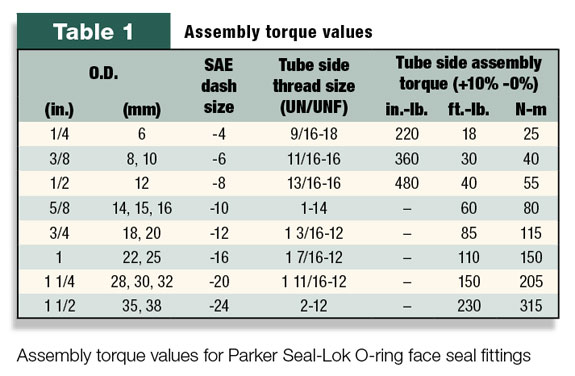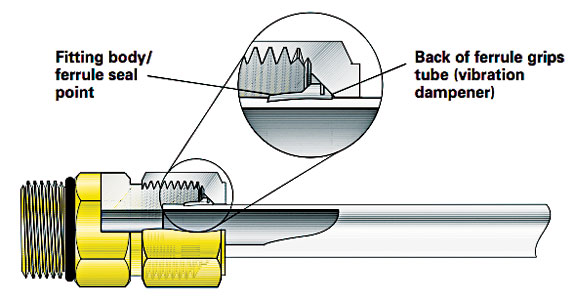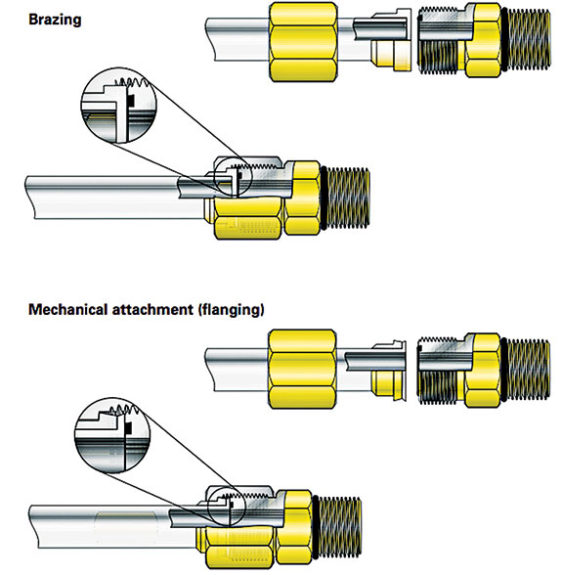Editor’s note: The following article is the second article of a two-part series regarding hydraulic tube fittings. This article will discuss O-ring face seal fittings and flareless bite-type fittings. Click here to read the first part. O-ring face seal O-ring face seal fittings (ORFS) have a fitting body, tube nut, sleeve and O-ring. The O-ring is seated in a captive O-ring groove (CORG) on the fitting’s flat face. The sleeve permanently attaches to the tube either mechanically (by flanging) or by brazing.
As the nut tightens onto the fitting body, the O-ring compresses between the body and the flat face of the tube flange (or braze sleeve) to form a tight, positive seal. O-rings provide a more reliable seal than traditional metal-to-metal connections – though they have more restrictions to the full range of media and temperatures.
O-ring face seal installation
A missing, pinched or partially extruded O-ring is the likely culprit for problems with this fitting type. There is also the misconception that ORFS fittings can be finger-tightened and will not leak.
When making ORFS connections, first check that the O-ring is properly seated in the groove. Then lubricate the O-ring to prevent assembly friction with the mating component. Lubrication can be completed with something as common as the system oil.

Correct ORFS assembly further involves the use of a torque wrench and SAE-recommended torque values ( Table 1 ).
Flareless bite-type
Also known as 24° flareless, this fitting consists of a flareless fitting body, tube nut and ferrule (also known as a bite ring). Some versions add an elastomeric seal to the bite ring to improve reliability.
All designs tend to function on the same principle. As the tube nut tightens, the ferrule wedges between the fitting body and tube. In doing so, the front end bites into the tube OD while the rear end grips the tube and isolates the bite area from vibration and flexural stresses. The ring’s bite provides the sealing capabilities needed to withstand the system pressures and impulses.

Flareless bite-type installation
Proper installation of the flareless bite-type fitting typically involves proper presetting of the ferrule into the tube. The initial mistake, however, is often an assumption that this type of fitting is a compression fitting, which it is not.
Compression fittings “squeeze” onto tubing, opposed to “biting” into. As a result, preset instructions are sometimes not followed to completion, and so the ferrule does not properly bite into the tube, resulting in an unreliable seal.
Proper presetting can be accomplished manually using a hardened Ferulset tool, the fitting body, or hydraulically using machines like Parker’s Hyferset tool or Hydra-Tool. Regardless of which method is used, it is important to complete each step in the assembly process leading up to installation: cutting, deburring and cleaning of the tube; ferrule preset; preset inspection; then final installation.
Cost of leakage
The obvious cost of system leakage is the loss of hydraulic fluid. The long-term expense of even a single small leak can come as a surprise to many …
• 1 drop per minute = 3.12 gallons per year = $56.12
• 1 drop per 10 seconds = 18.71 gallons per year = $336.70
• 1 drop per 5 seconds = 37.41 gallons per year = $673.40
• 1 drop per second = 187.06 gallons per year = $3,367.01
(Numbers based on 24 hours-a-day runtime at $18 per gallon; 250 working days)
Remember, this is for one leak point. Multiple leak points can drive fluid loss and cost up significantly. Consider enrolling in a training course to learn or brush up on hydraulic connection best practices. PD

DOUG STRICKER dstricker@parker.com






